The Sandman: Volume 4 – Season of MistsOriginal publication:
The Sandman #21–28 (December 1990 – July 1991)
Script: Neil Gaiman
Artwork: Mike Dringenberg (pencils)/Kelley Jones (pencils)/Matt Wagner (pencils)/Malcolm Jones III (inks)/P. Craig Russell (inks)/George Pratt (inks)/Dick Giordano (inks)
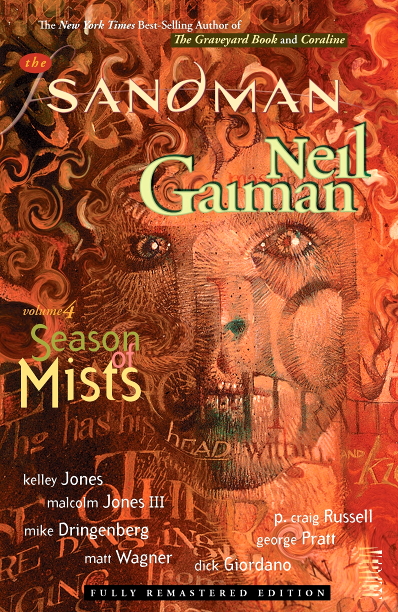 Publisher's synopsis
Publisher's synopsis:
Ten thousand years ago, Morpheus condemned a woman who loved him to Hell. Now the other members of his immortal family, The Endless, have convinced the Dream King that this was an injustice. To make it right, Morpheus must return to Hell to rescue his banished love -- and Hell's ruler, the fallen angel Lucifer, has already sworn to destroy him.Carrying on with Volume 4 of
The Sandman, "Season of Mists"...
As previously mentioned, I really enjoyed volume 3, "Dream Country", and felt that it was the point where Neil Gaiman's reach equalled his grasp, and where
The Sandman finally justified its reputation. "Season of Mists" continues that winning streak, initially setting up a fairly straightforward plot, in which Lucifer abdicates the throne of Hell, sends all the lost, damned souls that were consigned there back to earth, and gives the keys to our hero Morpheus (a.k.a. Dream). Of course, this is a classic "gift as curse" move on Lucifer's part, since Dream doesn't want the huge responsibilities associated with ruling Hell (he has more than enough hassles just being the Lord of Dream). However, plenty of other gods, demons, fairies, angels, etc do want to rule Hell, and that's the crux of this story.
The book begins with a family gathering of the Endless. We know Dream already, of course, and during the previous twenty issues of
The Sandman we've also met Death, Desire, and Despair. But here we meet Destiny and Delirium for the first time. Intriguingly, we also hear talk of a missing brother, though we don't learn his name at this point. Delirium is particularly memorable, with a personality that is decidedly odd, easily distracted and rather unstable (well, she would be, wouldn't she?). She is clothed in an outfit that reminds me slightly of Pris from Ridley Scott's
Blade Runner...
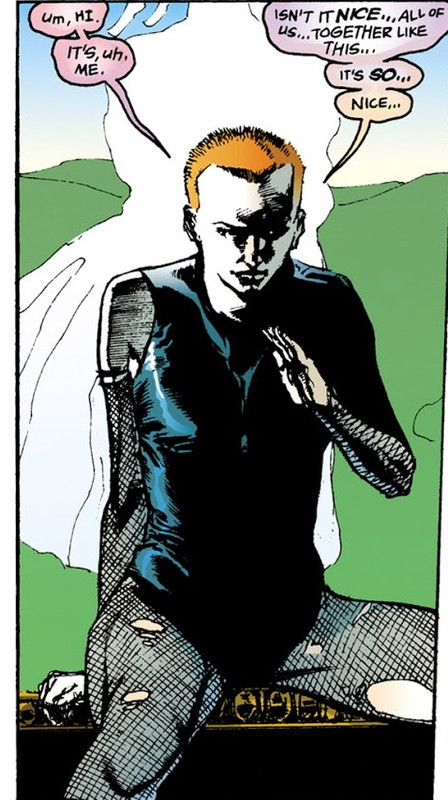
Death too changes her costume for this family meeting and sports a rather fetching Victorian-style dress (in an early nod to the goth sub-culture that is nowadays known as "romantic goth")...

Anyway, this isn't meant to be "Fashion Watch with the Endless", so let's move on.

The discussion at the Endless family reunion centres around a warning that Destiny has received from the Grey Ladies (the Three Witches from DC's old
The Witching Hour comic, who we first met in "Preludes & Nocturnes") that some undisclosed event is about to transpire which will have huge repercussions for the Endless. This, it turns out, is Lucifer's aforementioned abandoning of Hell. Morpheus's sister, Death, decides to get on her brother's case about his old love, Queen Nada. We learned of Nada's fate back in volume 2, "The Doll's House", where Gaiman showed us her tragic love affair with Dream: she was the ruler of an ancient African kingdom and lost her heart to Morpheus, with rather predictable problems arising from the love between a mortal human and one of the Endless. Morpheus, in a fit of pique, condemned Nada to Hell, where she was to remain for all eternity, for daring to have spurned him.
I mentioned in my review of "The Doll's House" that I liked how Gaiman isn't one to shy away from portraying his central "hero" in a decidedly unflattering light. Yes, Morpheus may be a supernatural, God-like personification of Dream, but he can also be a stubborn-headed, cruel arsehole. Anyway, during this reunion of the Endless, Dream's sister, Death, doesn't hesitate to tell her brother that he's done something very wrong, when it comes to Nada, and that he needs to make it right. We've come to learn that Dream is especially close to his sister and respects her council, and thus it's here that he first admits to himself that he's done something terrible. Of course, Death probably could've opened Morpheus's eyes to his wrong-doing a bit sooner...rather than, you know, leaving it for hundreds – if not thousands! – of years, while poor Nada rotted in Hell! But there it is.

By the way, something I just wanted to mention, which I thought was very, very cool, is that within the library in the realm of the Dreaming there are copies of all the books that various writers dreamed of writing, but never got around to completing. Of particular interest to me, as a big fan of J.R.R. Tolkien, was a copy of his
The Lost Road. This was a time-travel story that Tolkien began which would've connected his tales of Middle-earth to the 20th century. A rough structure for the book and four complete chapters concerning modern England and the island realm of Númenor were completed before the author abandoned the novel. Here though, in Morpheus's library, is the completed book...

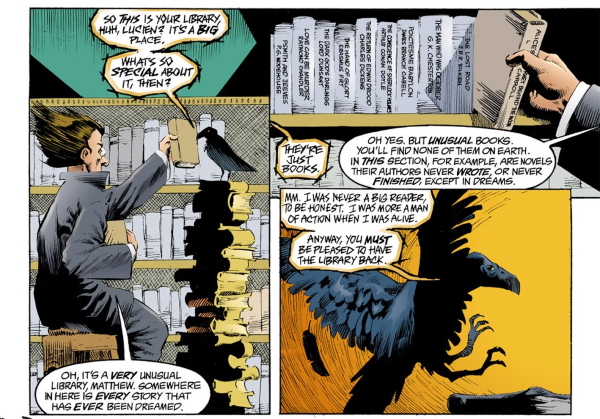
The build up to Morpheus having to return to Hell to confront Lucifer is nicely suspenseful. Gaiman does a brilliant job of ratcheting up the tension, as we are reminded that the last time Dream entered Hell – in order to locate his lost helmet in "Preludes & Nocturnes" – Lucifer swore to destroy him if he ever entered his domain again. To reinforce the notion that Morpheus may not survive his encounter with Lucifer, Gaiman has him visit his immortal friend Hob Gadling, and look in on the newly-born son of the deceased superhero Sandman and his wife Lyta. Unsurprisingly, Lyta is still furious with Morpheus for releasing Sandman from the dreamworld he was imprisoned in, which effectively caused him to cease to exist. To be fair, Dream is annoyingly vague in his discussions with Lyta, so her fury is pretty understandable under the circumstances. Morpheus names the infant Daniel, in a very powerfully written and drawn scene...
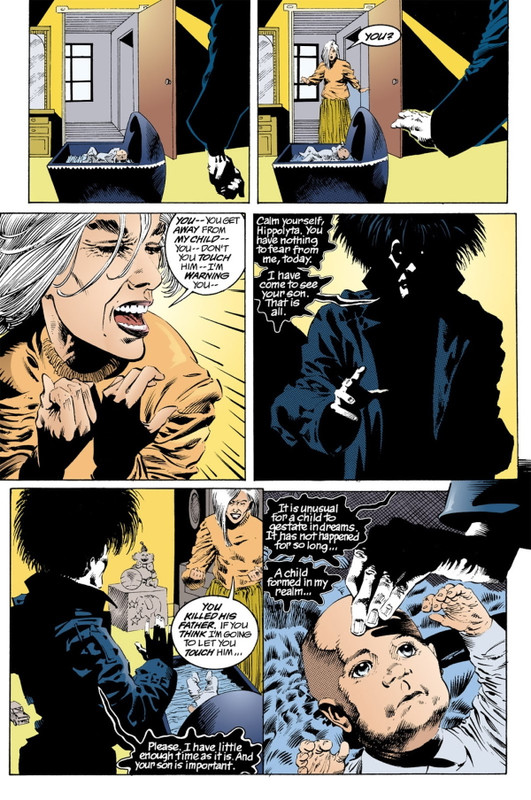
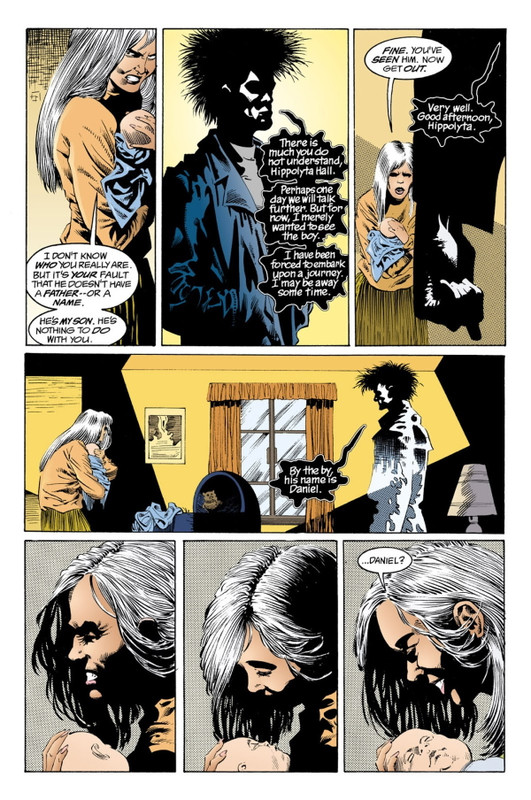
Upon arriving in Lucifer's domain, Morpheus finds the fallen angel in a conversational, rather than a confrontational mood – and Gaiman writes some truly excellent dialogue between the two here...

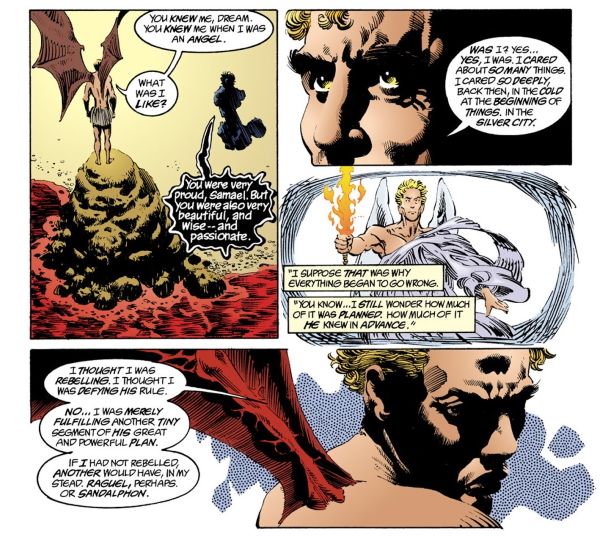
Lucifer's sly bequeathing of the keys to Hell to Morpheus accompanies his emptying of the cells of the Underworld, which results in Nada's disappearance, much to Morpheus's frustration.
Once Dream is burdened with the keys to Hell, the narrative centrepiece of "Season of Mists" becomes a grand banquet held in the house of Dream, where an assembled throng of interested parties vie for Morpheus's favour, hoping to obtain the keys for themselves. Here we meet such mythological and theological deities as Thor, Odin, Loki, Anubis, Bast, Azazel, and Oberon and Titania of the faerie among others. The assembled creatures and demigods present their bids, petitions and bribes to Morpheus in the hope that he will pick them to receive the keys. I must say that I think Gaiman does a great job of giving the various mythological figures and demigods distinct personalities – my favourite being the personification of chaos, who is depicted as a mischievous little girl with a balloon. I'm pretty sure that there would be many parents who would wholeheartedly agree with the realism behind such a depiction of chaos!


As I mentioned earlier, one consequence of Lucifer having closed the gates of Hell is that all the damned souls that resided there have been sent away, with some of them beginning to appear on Earth again. As a result, we get an excellent story-within-a-story sequence about a private British boarding school that now has a problem with old pupils and schoolmasters returning from the dead. This, for me, was one of the most enjoyable parts of "Season of Mists". The story is at turns gripping, funny, and heartbreaking in pretty equal measures.
This chapter is drawn by Matt Wagner, and I've gotta say that on the surface of things, his art style is not at all to my liking. It looks rather hurried, lacking in artistic finesse, and well below par for him – but perhaps it is deliberately so? To my eye, Wagner's scribbly style calls to mind the absent-minded jottings you might find in the back of a school exercise book, which, as I say, might be wholly intentional, and is certainly appropriate for this interlude about a British boarding school and its undead teachers and pupils. The artwork also does a grand job of conveying Gaiman's dark humour and biting satire...

I have to wonder if this chapter might be a little too "English" for American audiences? Certainly I have no doubt that it will resonate with anyone who went to either a private or public British school at any time between the 1950s and the 1980s (as I did). I'd also bet my hat that this sequence is at least partly autobiographical on Gaiman's part.
By the conclusion of "Season of Mists", things have more or less been put back the way they were, with all the damned souls having returned to Hell, which is now run by two former members of the angelic heavenly host. Morpheus locates and rescues Nada from the demon Azazel, who was hiding her soul within him. He apologises to his old lover and seeks her forgiveness, before reincarnating her as a newborn baby. In a moving scene, he tells her that she will always be welcome in the Dreaming. If I was to pick out one minor criticism of "Season of Mists", it would be that this "illusion of change"-style ending felt a little lazy, but that would be a nitpicky criticism because, actually, the ending is very satisfying.
Gaiman's writing in this book is of a very high quality, and the artwork of Kelley Jones (who illustrates most of the arc) serves the story well, while looking great with a number of different inkers embellishing his work. Mike Dringenberg brings his usual slick, yet slightly unkempt art style to the book's first chapter.
The previous volume of
The Sandman showed us what the series was capable of, but it was also made up of four filler issues that, while excellent, didn't really advance the overarching plot, such as it is. "Season of Mists", on the other hand, certainly does move the narrative forward and, for this reader, is the point where
The Sandman crystallises into what it always promised to be